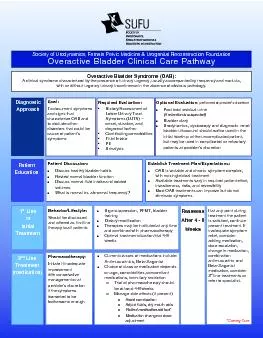

Overactive Bladder Clinical Care Pathway Overa ctive Bladder Syndrome OAB A clinical syndrome characterized by the presence of urinary urgency usually accompanied by frequency and nocturia with ID: 832615
Download Pdf The PPT/PDF document "Society of Urodynamics, Female Pelvic Me..." is the property of its rightful owner. Permission is granted to download and print the materials on this web site for personal, non-commercial use only, and to display it on your personal computer provided you do not modify the materials and that you retain all copyright notices contained in the materials. By downloading content from our website, you accept the terms of this agreement.
Society of Urodynamics, Female Pelvic Me
Society of Urodynamics, Female Pelvic Medicine & Urogenital Reconstruction Foundation Overactive Bladder Clinical Care PathwayOveractive Bladder Syndrome (OAB):A clinical syndrome characterized by the presence of urinary urgency, usually accompanied by frequency and nocturia, with or without urgency urinary incontinence in the absence of obvious pathology.DiagnosticApproachPatientEducationGoal:To document symptoms and signs that to exclude other disorders that could be cause of patient’s symptomsRequired Evaluation: History/Assessment of Lower Urinary Tract Symptoms (LUTS) – onset, duration, and degree of bother Contributing comorbiditiesFluid Intake PEUrinalysisOptional Evaluation: performed at provider’s discretionPost void residual urine (if retention is suspected)Bladder diary Urodynamics, cystoscopy and diagnostic renal/bladder ultrasound should not be used in the initial work-up of the uncomplicated patient, but may be used in complicated or refractory patients at provider’s discretionPatient Discussion: Discuss healthy bladder habitsReview normal bladder functionvolumes What is normal vs. abnormal frequency?Establish Treatment Plan/Expectations: OAB is variable and chronic symptom complex, with no single ideal treatmentAvailable treatments vary in required patient effort, invasiveness, risks, and reversibilityMost OAB treatments can improve but do not eliminate symptoms 1st LineorInitialTreatmentBehavior/Lifestyle: Should be discussed therapy to all patientsUrge suppression, PFMT, bladder trainingTherapies may be instituted at any time and combined with pharmacotherapyOptimal treatment duration/trial 4-8 weeksReassessAfter 4 - 8WeeksPharmacotherapy:Initiate if inadequate improvement with conservative management or at provider’s discretion if the symptoms warranted to be bothersome enoughIf at any point during treatment the patient present treatment. If inadequate symptom relief, consider adding medication, dose escalation, change in medication, combination antimuscarinic and Beta-3 agonist medication, consider 3rd line treatments or refer to specialist.Current classes of medications include: Antimuscarinics, Beta-3 agonist Choice of class or medication depends on age, comorbidities, concomitant medications, formulary restriction Trial of pharmacotherapy should be at least 4-8 weeksManage side effects (if present)Avoid constipationPatient medication aid tool*Medication change or dose adjustment2nd LineTreatment (medication)*Coming SoonChemodenervation:Ex: BOTOX®Cystoscopic bladder injection of Onabotulinumt
oxinAMust be repeated 1-2 x per year to
oxinAMust be repeated 1-2 x per year to Contraindications: inability to perform self-catheterizationRefractory Uncomplicated OAB: The patient has failed suf�cient behavioral therapy trial and pharmacotherapy with at least one medication. Clinicians may offer advanced treatments in any order, however there are certain patient characteristics that may favor one intervention over another.Complicated OAB: In the patient with concomitant neurologic disease, prior genitourinary surgery, obstructive voiding symptoms, consider urodynamic, cystoscopic, or radiographic evaluation of the urinary tracts as necessary to rule out confounding diagnostic factors that may in�uence treatment - such as foreign body in bladder or outlet, bladder outlet obstruction, elevated post-void residual urine volume, or hydronephrosis. The provider will then determine if advanced therapy is still appropriate or if other options should be considered.Advanced Therapy info@sufuorg.com or visit the website: www.sufuorg.comDisclaimerThis Clinical Care Pathway (CCP) was written by the Overactive Bladder Clinical Care Pathway Panel of the Society of Urodynamics and Female Pelvic Medicine and Urogenital Reconstruction (SUFU). While this CCP does not establish the standard of care, SUFU offers this aid to assist providers in their practices related to the condition being treated. The Clinical Care Pathway does not pre-empt provider judgement in individual cases. Providers must take into account variations in resources, patient tolerances, needs, and preferences. Conformance with any clinical guideline or clinical care pathway does not guarantee a successful outcome. The CCP may now or in the future include text or information regarding treatments or options that are not approved by the Food and Drug Administration. The provider is encouraged to carefully follow all available prescribing information about indications, contraindictions, precautions and warnings. The CCP is not intended to provide legal advice about use and misuse of these options. InterStim® is a registered trademark of MedtronicBOTOX® is a registered trademark of AllerganNURO-PTNM® is a registered trademark of MedtronicUrgent PC® is a registered trademark of Cogentix MedicalSacral Neuromodulation:Ex: InterStim®Minimally invasive surgical implantation No maintenance therapyBattery life 3-5 yearsContraindications: Need for MRI below the neckPosterior Tibial Nerve Stimulation: Ex: NURO-PTNM® or Urgent PC®Of�ce-based percutaneous needle stimulationminutes x 12 weeks followed by regular maintenance therapy, as neededContraindications: severe LE edema or venous disease3rd LineOrAdvancedTherapies